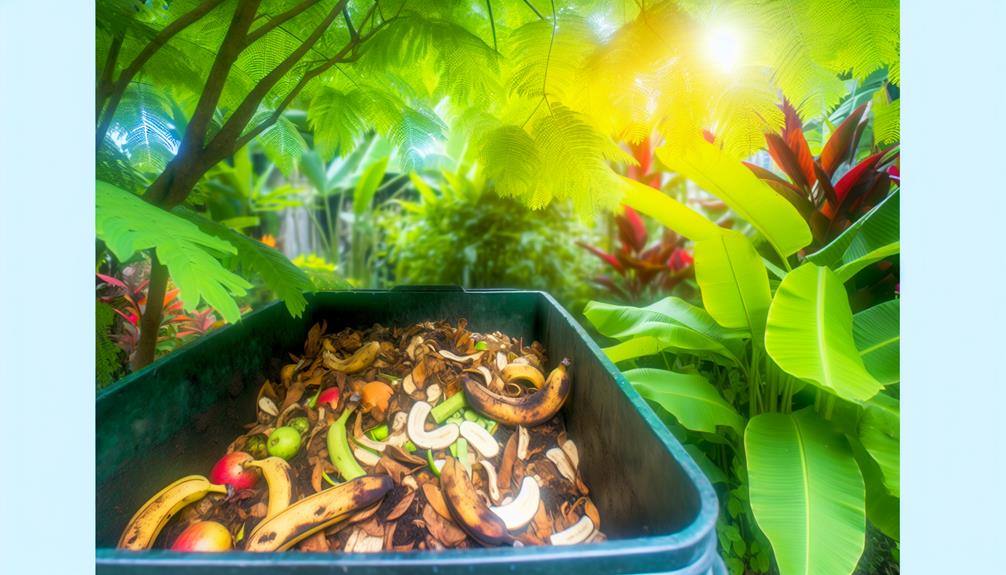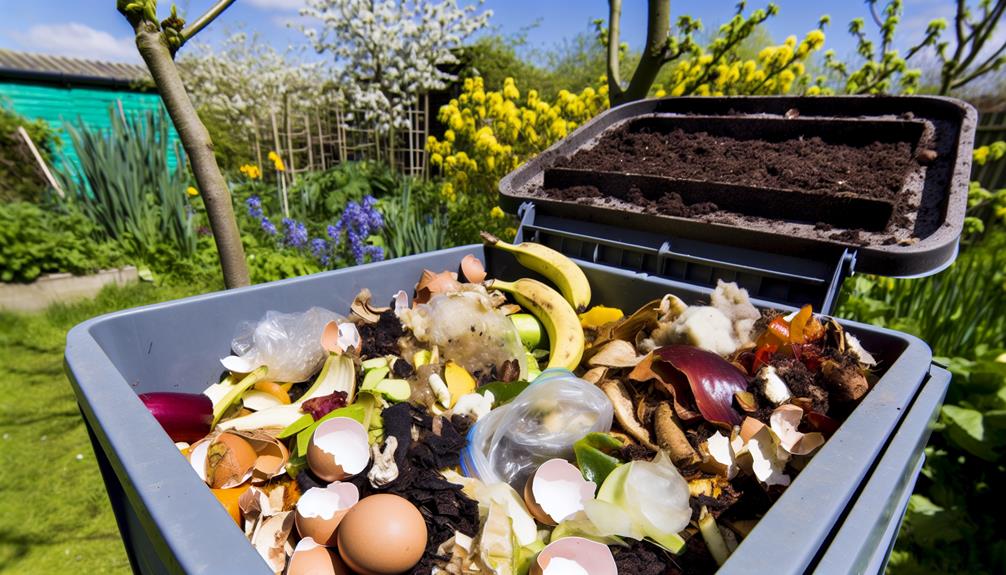

Yes, you can compost rotten bananas. Start by removing the peels and cutting both the peels and flesh into small pieces. This increases the surface area and accelerates decomposition. Mix the banana pieces into your compost, making sure they’re evenly distributed among other compost materials.
Balance your compost by maintaining a 2:1 ratio of brown materials, like dried leaves, to green materials, including bananas. Regularly turn the compost pile to promote faster breakdown and maintain proper aeration and moisture levels, similar to a damp sponge. By following these steps, your compost will be enriched with nutrients. For more efficient composting techniques, stay tuned.
Composting rotten bananas enriches your soil with essential nutrients and organic matter. When you compost these bananas, you’re creating vital rich soil that’s perfect for your garden.
The high potassium and phosphorus content in bananas can enhance plant growth and improve flower and fruit production. By adding them to your compost pile, you’re contributing valuable organic material that helps improve soil structure and water retention.
You’ll also be part of a community effort towards waste reduction. Instead of tossing those overripe bananas into the trash, you’re making a necessary choice that benefits both your garden and the environment. Reducing food waste is essential, and composting is a simple, effective way to do it.
Moreover, composting fosters a sense of belonging among like-minded individuals who care about sustainability. You’ll find that many gardeners and eco-conscious folks are keen to share tips and support each other. Engaging in composting can connect you with this community, providing opportunities to share your experiences and learn from others.
Also Read: Can You Compost Celery?
Before adding rotten bananas to your compost pile, you’ll need to prepare them properly to make sure they decompose efficiently. Start by examining the bananas to understand their current state. The ripening process continues even after bananas are stored, so check if they’re overly soft or have turned black.
If your bananas are still in their peels, remove the peels first. Peels can be composted separately, but it’s important to cut both the peels and the banana flesh into small pieces. This step accelerates decomposition by increasing the surface area exposed to microorganisms.
Consider your banana storage practices. Bananas stored in cool, dry places ripen slower than those left in warm, humid environments. If they’ve been in a humid area, they might be mushier and easier to break down. Use a knife or your hands to mash them up if they’re too soft to cut.
Once you’ve prepared the rotten bananas, simply mix them into the compost pile to boost its nutrient content. Start by cutting the bananas into smaller pieces, including the banana peels. This step helps them break down more quickly. If you have a compost bin, layer the banana pieces and peels with other compost materials like leaves, grass clippings, and kitchen scraps.

Banana peels are rich in potassium, which is essential for plant growth. They also contain calcium, magnesium, and sulfur, which contribute to the overall health of your compost. By incorporating these into your compost, you’re enhancing its quality and making your garden soil more fertile.
To make sure the bananas decompose efficiently, mix them well into the compost pile rather than just placing them on top. This helps distribute the nutrients more evenly and speeds up the decomposition process. If your compost bin has a lid, make sure it’s securely closed to keep pests away.
Regularly turning the compost helps aerate the pile and promotes faster breakdown of all materials, including the bananas.
Also Read: Can You Compost Basil?
To maintain an efficient compost pile, it is vital to balance green and brown materials for best decomposition. Green materials, like rotten bananas, provide nitrogen, while brown materials, such as dried leaves, offer carbon. Achieving the right compost balance guarantees an ideal nutrient ratio that supports microbial activity, necessary for breaking down organic matter.
When adding any material to your compost, aim for a rough 2:1 ratio of browns to greens. This helps maintain proper aeration and moisture levels. Here’s a simple table to help you understand and balance your compost pile better:
| Material Type | Examples | Ratio Contribution |
|---|---|---|
| Green Materials | Rotten bananas, grass clippings | Nitrogen |
| Brown Materials | Dried leaves, cardboard | Carbon |
| Ideal Balance | 2 parts brown, 1 part green | Best |
Also Read: Can You Compost Barbecue Sauce?
Balancing your compost is essential, but it’s just as important to know the common mistakes that can hinder the decomposition process. A successful compost pile requires more than just tossing in your kitchen scraps and garden waste. Avoid these common pitfalls to guarantee your compost thrives:

Yes, you can compost banana peels separately from the fruit. The peel’s texture breaks down slowly, so it contributes to the overall nutrient breakdown. You’ll be helping the community create richer compost for everyone’s gardens.
Yes, rotten bananas can attract pests to your compost bin. To guarantee effective pest control and compost maintenance, cover them with browns like leaves or paper. This way, you’ll keep the compost community thriving and pest-free.
Rotten bananas decompose in compost within a few weeks. Their aerobic digestion speed depends on microbial activity. By maintaining a balanced compost pile, you’ll foster a community where microbes thrive, helping everyone contribute to a greener planet.
You can definitely compost bananas with other fruits and vegetables. Just maintain nutrient balance by mixing green and brown materials. Use proper compost layering to guarantee everything breaks down efficiently, creating rich, fertile compost for your garden.
Yes, there are! Plants like roses and tomatoes thrive with a nutrient boost from banana compost. Their soil enrichment will enhance growth and make you feel more connected to your flourishing garden community.
Composting rotten bananas is a straightforward way to enrich your soil. Remember to chop them into smaller pieces for faster decomposition.
Balance your compost by mixing green and brown materials, ensuring it remains well-aerated.
Avoid common mistakes like overloading with bananas or letting the compost become too wet.
By following these steps, you’ll create nutrient-rich compost, benefiting your garden and reducing waste. Start composting your rotten bananas today and see the results in your garden!
